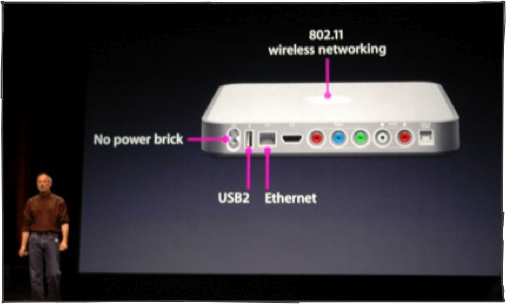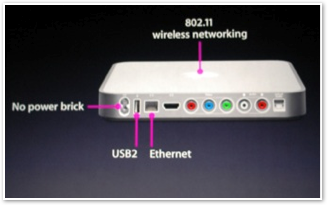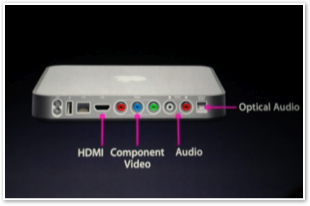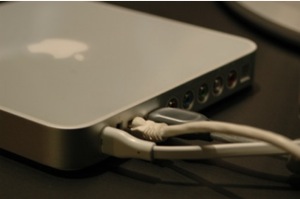





Apple's surprise announcement of a $299 “iTV” set top box was a confusion for some because Apple didn't call it what it really is: the Video Airport Express. Here's a closer look at the new device, and how it fits in with Apple’s online media strategy.
Big Little Package
Apple didn't advertise the full specs on the device, only showing off what looked like a thin slice of a Mac mini, with networking, USB, audio and video ports, and a brief demonstration of its extended Front Row interface. Sometimes saying a little says a lot.


This isn't a Mac. There isn't room for an optical drive; its nearly the size of one itself. Further, there isn't enough room inside for a general purpose Intel Core processor and necessary cooling, or other typical PC hardware. It even has the power supply transformer built in, so it only uses a thin power cable.



This is an appliance, the video Airport Express: it lacks everything else. It has no dedicated display, and no user interface beyond the simple TiVo-like Front Row.
It uses a remote control, not a keyboard, so it only needs a single USB port, possibly for printer sharing or disk storage. This is designed to stick next to a TV, just as the AirPort Express hid behind a stereo.
Why isn't it ready yet?
PC critics have asked how the iTV would be any different from existing wireless extenders. Well for starters, it's not here yet.
That’s right: Apple very uncharacteristically announced plans for a product that won't be available for possibly another six months, the first quarter of 2007.
How is it that Apple could be struggling to ship something that already commonly exists elsewhere? Why has Apple pre-announced it as a product rather than directing all the attention to the revamped iPods and the new game and movie downloads?
As I pointed out in Why Apple is Winning in Media Downloads, wireless distribution is a key part of Apple's download media strategy. The outstanding problem of course, was presented in A Visual Comparison of CD, DVD, HD and iTMS: video is simply really big, vastly larger than audio data.
While 802.11g, aka Airport Extreme, is good enough for AirTunes audio streaming, it isn't really good enough for streaming video. Yes, it can in ideal conditions, but only at very low quality, and not very reliably.
In order to stream movies around, users will want at least 100 mbit/s Fast Ethernet speeds. However, running network cables around isn't always desirable or even possible. Further, it detracts considerably from the convenience of using iTMS for content. Apple needs wireless distribution to ice the iTMS cake.
Airport Express Extreme!
Apple's new iTV is being held up, I believe, because Apple is waiting to deliver 802.11n, the next major jump in wireless networking. As I noted earlier, the n standard isn't going to be finalized until early 2007. While some vendors are releasing "pre-n" wireless equipment in advance of the standard, I believe Apple is holding off to make sure their equipment will be widely compatible and not interfere with existing networks.
Apple helped to pioneer 802.11b under the brand AirPort, and was among the first to productize 802.11g under the AirPort Extreme name. The newer Macs also have 802.11a, a business-oriented version of wireless networking that offers g speed on a different radio frequency.
Apple initially skipped supporting a, partly because it doesn't work well in consumer settings (its higher radio frequency is blocked and absorbed easier), but since it is supported for free in modern wireless chips, Apple now throws in a, along with b and g support in the Intel Macs. Here's a comparison of the maximum and typical speeds of a, b, g and n, compared with the network cable speeds of Fast Ethernet and Gigabit Ethernet:



Going Wireless with n
Comparing the major jump in the speed of n, it's clear that it would be much better suited for wireless video distribution.
Existing wireless video products, such as Sony's LocationFree, can wirelessly send TV quality video to Sony displays, or even beam TV across the Internet to remote tablet TVs or a remote laptop.
To do this using existing wireless technology however, Sony has to effectively limit the bitrate of video to 300 kbit/s. That's a lower bandwidth threshold than the typical iTMS TV programming Apple was selling.
Sony's product is sold as a convenience and novelty. Sony also has a very different business model and product lineup than Apple; Sony sells TVs, stereos and other AV equipment.
LocationFree is a cool way to stream a signal to play on various TVs, and a way for Sony to sell their AV gear to TV viewers who might want to watch their cable TV programming from a distant hotel room.
Apple doesn't sell TVs, or receivers, or any other AV gear, apart from the iPod, iMacs, and some speaker systems. Apple is developing a business in online movie and TV programming. Current programming was designed for the iPod display, or a dock-connected TV. Even at this limited TV quality, the content Apple was selling in the iTMS was too much data to reliably stream wirelessly.
Realistically, that quality of video isn't something people want to struggle to watch on their home theater equipment or fancy HDTVs anyway. It's VCR quality, and targeted for mobile iPod use. Yesterday's announcement to boost Apple's iTMS video quality into "near DVD-quality" with Dolby surround audio means that Apple is now pushing beyond what the iPod displays natively into a higher quality model that brings Apple into the home theater arena. In order to make that happen wirelessly, Apple needs a better wireless technology than Airport Extreme can provide. Apple needs n.
Wireless, Near DVD-Quality
While enough users were satisfied with TV quality video for TV programming, DVDs simply provide much better video; Apple would have a tougher time selling TV quality movies as an option against Netflix or DVD purchases.
or DVD purchases.
I've downloaded iTMS TV and short films for viewing on TV and with a standard definition 1024 x 768 video projector. I also have compressed DVD video to similar TV-quality for use on the iPod; this level of quality is generally acceptable for some things. It is distracting for content with sharp details; ending credits look mushy for example. It's obviously not ideal for watching blockbuster movies on a big screen.
Apple struck a balance between its existing TV quality downloads and the much larger requirements of DVD or HD quality video, by offering content that rivals DVD, but is still small enough to use on the iPod.
Users of 5G ipods will be happy to hear that the new higher quality video used for iTMS TV and movies will play back on their existing iPods just as before.
This near DVD-quality video will also enable Apple to wirelessly deliver movies from a Mac to a stereo and TV, creating a workable solution for users who want an easy way to watch iTMS content, along with their iTunes, photos, home movies and everything else, in the same way the AirPort Express' AirTunes currently streams music.
But Wait, There's More
Many consumers will want options beyond downloadable movies however. An increasing number of people want a system able to take full advantage of their HD ready displays or projectors, something that downloads can't effectively do. Rather than locking users into a single option of downloadable content, Apple has borrowed a page from the iPod strategy book: give users a choice.
Apple outfitted the new device with HDMI and component video. If all the iTV could do was 640 x 480 iTMS video, Apple would have simply used a VGA adapter or super video connector, just like the existing iPod dock. It is quite obviously designed to play HD content. Apple even demonstrated the iTV playing back HD content.
That ties this new device into a blossoming platform outlined by Front Row: it plays local videos, DVDs, HD trailers, and now, near DVD quality downloadable movies and TV. Users won't have to choose, they can have it all. As with the existing iPod and Airport Extreme, users can buy music online, use their existing collection, keep buying CDs, or any type of combination.
Why Announce It Now?
Apple could have released iTV today as an Ethernet only device, but that would have served a much smaller need. What's the point of running an Ethernet cable to a box cabled to a TV, instead of simply running a video cable directly to the remote TV, and not needing a box at all? The iTV is largely about offering wireless playback, following an identical model to AirTunes.
That hinges all the holdup on wireless n, with the capacity to deliver competitive video quality. Apple is also no doubt polishing its Front Row software to perform well as an appliance system for wirelessly connecting to shared content on a Mac, browsing trailers on the web, navigating around photos and music, and hopefully, streaming playback from a remote Mac’s DVD player.
Apple announced the iTV so that users would know Apple has a strategy for delivering wireless content at a higher quality than existing systems. That's the most roadmap information Apple has provided in the consumer space in a while, and is a welcomed change.
Now that Apple has set a pattern of consistently delivering progressive development throughout its product line, it has more freedom to announce future directions and expect consumers to have confidence in Apple's ability to actually deliver them.
Open Apple
It would be smart for Apple to encourage electronics manufacturers to support a standard control protocol for wirelessly sharing and advertising their content via Bonjour and Front Row, just as Apple got printer manufacturers to support automatic discovery using Bonjour. 

Imagine home theater components, from TVs and stereos to cable boxes, which all listened for instructions from a Front Row device like the iTV, and could be automated to turn on, record programming, change channels, browse and play stored content using a slick iTV device and a single remote as simple as Apple's.

Sept 14th Update
iTunes Remote Control
Reader Jody Sweeton pointed out a new feature in iTunes 7: a preference setting for allowing remote speakers to control iTunes. Sure looks like this is designed to allow a remote device, say an embedded iTV appliance running Front Row, to send control information to iTunes.

This would do the reverse of what I described as a home media center application of The Xserve mini. Rather than having a remote server that acts as a central storage system for iLife content, it looks like Apple is presenting a home’s primary Mac or PC as the digital hub, and positioning the new iTV, and perhaps a new revision of the Airport Express, as a remote player console to manage a central repository on the home computer.
No DVR/PVR or DVD Burner/Ripper?
Lots of people seem worried that the iTV doesn’t have a tuner or hard drive recorder for over the wire or cable TV, nor can it burn, play, or rip DVDs. Well, it also can’t browse the web. Fortunately, any Mac or PC can do all of those things. This device is a video Airport Express, remember?
It’s a way to wirelessly beam high quality audio and video (as well as photos and music) from a Mac or PC for output to a television and stereo system. A lot of effective engineering is about knowing when to stop adding features.
I’m also compelled to point out that I think the iTV should be called Airport AV.
Remember that the point of the Airport Express is to not just beam audio, but to beam any music, including DRM iTMS songs, to remote speakers. It does this by encrypting the data between iTunes and the Airport Express.
The iTV will do the same encrypted streaming; that means Apple can play DVDs from a Mac, and hopefully a PC, remotely to the device without facing the wrath of studios worried about users somehow using the DVD in ways they failed to lock down in insane ways. 

Apple might even be able to get away with adding DVD ripping to iTunes, if it encoded the resulting iPod-sized rips to use FairPlay to prevent wholesale duplication and “sharing” of movies. Of course, tools like Mac the Ripper and Handbrake also exist, so its not really necessary.
Many readers also pointed out that the obvious point of the USB connector was to directly connect an iPod dock. That makes sense.
This Series

| | Comment Preview
 Read more about:
Read more about:

 Send |
Send |

 Subscribe |
Subscribe |
 Del.icio.us |
Del.icio.us |
 Digg |
Digg |
 Furl |
Furl |
 Reddit |
Reddit |
 Technorati
Technorati
Click one of the links above to display related articles on this page.
How Apple's iTV Media Strategy Works
Wednesday, September 13, 2006






Ad










